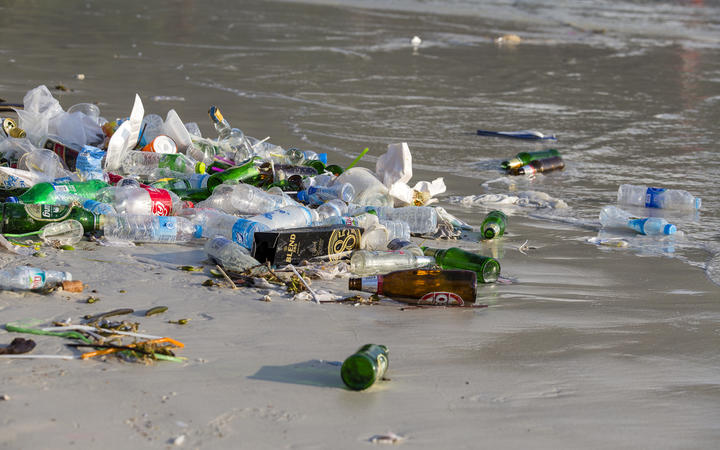Natural fibres more prevalent in ocean than plastic – study
Rubbish made from natural fibres could be polluting oceans at far greater rates than plastic, an expert on marine plastics says.

A world champion free diver in the ocean off the coast of Istanbul to draw attention to the problem of pollution in the ocean. Photo: AFP
Professor Peter Ryan of the University of Cape Town has recently had a study published in New Scientist.
It showed that the large majority of the microfibres polluting our oceans are not plastic – which has long been assumed – but actually natural fibres like cotton, wool and other celluloses, such as linen and flax.
Professor Ryan told Sunday Morning that this was observed by one of his colleagues during an Antarctic circumnavigation expedition, and it was surprising because the Southern Ocean is by far the cleanest ocean in terms of plastic pollution, he said.
The fibres are identified by precise “tedious’ work involving the use of a small beam of infra-red light shone on the tiny fibres. Only 8 percent of the fibres recovered from the Southern Ocean were plastic.
“The natural fibres that we’ve been putting out for much longer than we’ve been putting out synthetic fibres are also accumulating in the ocean for some reason. We don’t understand why that might be…
“Their densities in the ocean are much much higher than so called micro plastics.”
The biggest concern for marine life was the natural fibres’ impact of clogging of filter-feeders which adapted to deal with non-food items in their filter stream so it was a moot point what the full impact was.
Putting plastic items into rivers
Ryan’s own recent research attracted controversy because it involved putting plastic items into rivers and tracing them.
He said most washed ashore – so if beaches are regularly cleaned, especially around rivermouths, it can have a large influence on how much plastic ends up in the ocean.
“The plastics we put deliberately into rivers to see where they go we get typically between 80 and 100 percent recovery rates, admittedly from relatively small rivers. If you’ve got a really big river it might be a different story.
“That means that if you clean beaches regularly around river mouths you can make quite a significant impact on the amount of plastic getting out into the ocean.”
Ryan said close to land, flexible packaging was the most visible sight but the items changed further out.
“Interestingly, what we find in terms of washing up on beaches, buoyancy is very important, so the more buoyant an item is the more likely it will wash up on shore.”

Tourists generate more trash in small island developing states – and 80% ends up in the ocean. Photo: Oleg Doroshenko/123RF
He said the evidence was the vast majority of plastic is still in larger form which was good news but once it degraded into micro-plastic it was much harder to deal with.
‘Missing plastics’ debate
Some scientists have estimated that between 5 million and 12 million tonnes of plastic was moving from land into the sea.
Ryan said 250,000 to 300,000 tonnes were estimated to be drifting on the surface and while this was an unacceptably large amount, it was a vast difference to some scientists’ figures.
It had become “the missing plastic plastic debate” with scientists trying to explain the difference.
“We’re coming to the conclusion in South Africa, at least, that the missing plastic doesn’t exist in the first place.”
He had recently been on Pitcairn Island and found New Zealand trays, used in the fishing industry that were all dated pre-2000, while all those that had washed up on the island that were from South America were a lot more recent.
This suggested environmental progress in this country’s fishing industry, he said.
